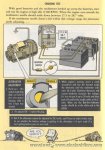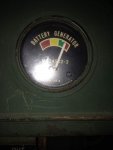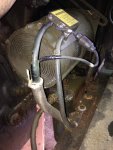Just put a used alt off a 900 series truck on my deuce. I've searched for keywords and skim read through the Alternator TM 9-2920-225-34 twice, as well as searched the forum I can't find the exact procedure for on-the-truck voltage adjustment. Closest I could find was on the testing machine, they adjusted the load to 60a and volts should read "about" 28.
I tested at idle at the alternator with no lights or accessories on exc fuel pump. I was getting 28.5v and read on Erik's that it should be 27.6v (13.8x2), so I turned it down to 27.1 to be on the safe side.
My pot is backwards...I turned it counterclockwise or out initially and got 30+v.
Should I test with load...? Test at batts too...? Anything else?
Thanks
I tested at idle at the alternator with no lights or accessories on exc fuel pump. I was getting 28.5v and read on Erik's that it should be 27.6v (13.8x2), so I turned it down to 27.1 to be on the safe side.
My pot is backwards...I turned it counterclockwise or out initially and got 30+v.
Should I test with load...? Test at batts too...? Anything else?
Thanks






